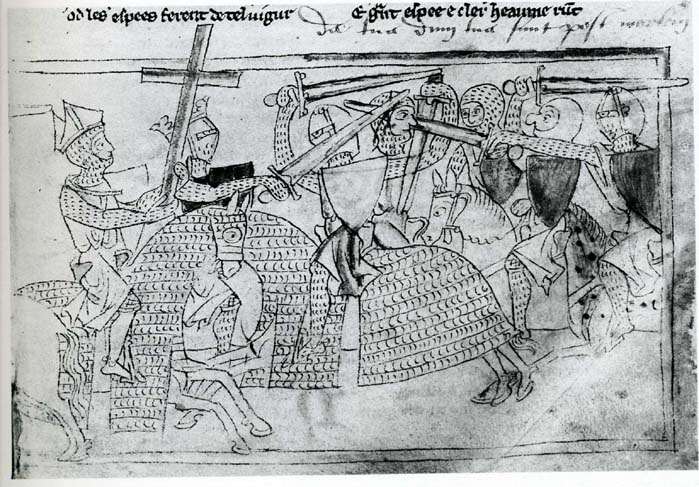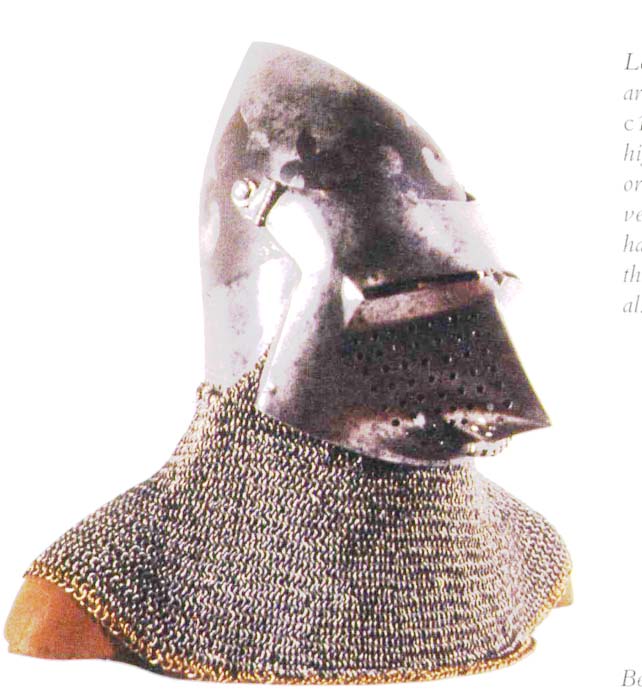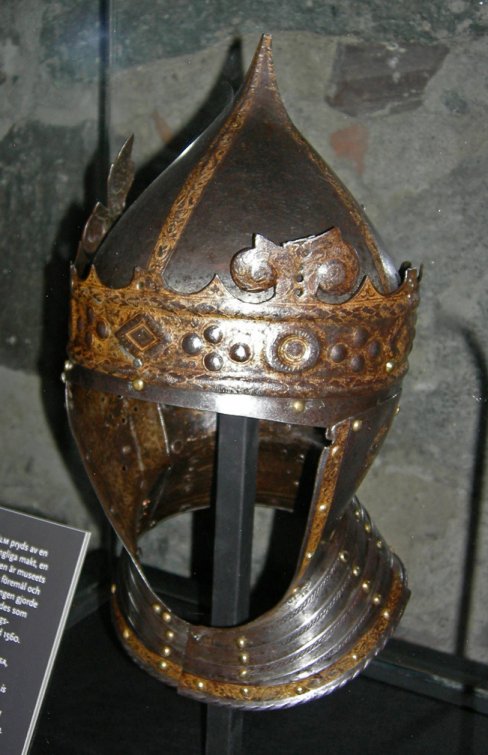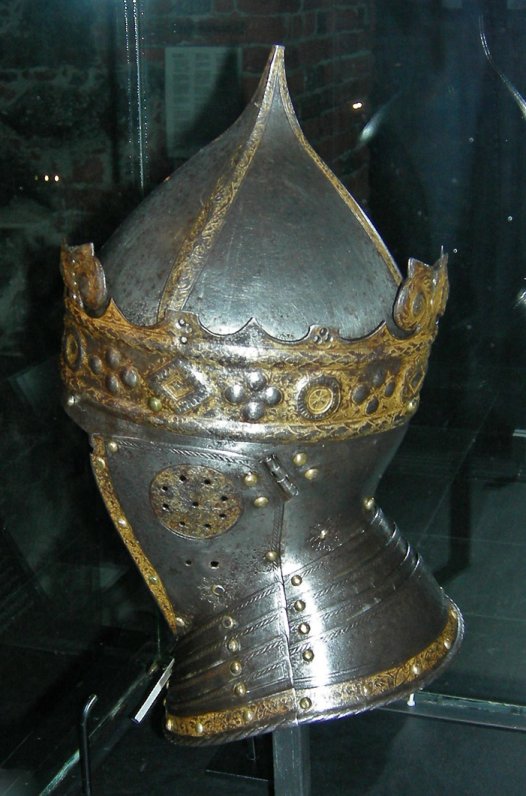Hey everyone, quick question. In the Maciejowski Bible, there seems to be a lots of helms with crowns on top of them. I was wondering if these are found in archeology or in literary accounts of the period. Do you guys think they existed or is it just artistic convertion to help point out important people in the picture? Oh and does anyone have any info about the round shields being used by the philistines? Thanks in advance.
Stephen,
I'd imagine crowns were used. The effigy of the Black Prince (admittedly over a 100 years later than the Mac Bible) shows a crown on his bascinet:
[ Linked Image ]
The Black Prince's great helm, though, has no crown, just a lion as a crest:
[ Linked Image ]
A period illustration of Edward III also shows a crowned bascinet:
[ Linked Image ]
Henry V wore a crowned helm at Agincourt and had part of it damaged by a blow from a french (often thought to be the Duke of Alencon). A surviving helm attributed to him is a tournament great helm with no evidence of a crown. But every account of Agincourt I've read talks about his crown being struck.
The Romance of Alexander (c. 1340) shows a crowned bascinet:
[ Linked Image ]
Below are some more examples. The first is a 13th century illustration (not from the Mac Bible) showing a crowned great helm. I ripped a page in my book scanning this one. Grrrr.....
The second is a bascinet from Chartres cathedral. The patination shows where a crown used to be.
So, I think it's perfectly reasonable. We have more period art from that century that shows it than just the Mac Bible. We have period art from the 14th century and a surviving helm that shows it. And we have literary accounts from the 15th century.
 Attachment: 114.34 KB
Attachment: 114.34 KB

 Attachment: 72.04 KB
Attachment: 72.04 KB

I'd imagine crowns were used. The effigy of the Black Prince (admittedly over a 100 years later than the Mac Bible) shows a crown on his bascinet:
[ Linked Image ]
The Black Prince's great helm, though, has no crown, just a lion as a crest:
[ Linked Image ]
A period illustration of Edward III also shows a crowned bascinet:
[ Linked Image ]
Henry V wore a crowned helm at Agincourt and had part of it damaged by a blow from a french (often thought to be the Duke of Alencon). A surviving helm attributed to him is a tournament great helm with no evidence of a crown. But every account of Agincourt I've read talks about his crown being struck.
The Romance of Alexander (c. 1340) shows a crowned bascinet:
[ Linked Image ]
Below are some more examples. The first is a 13th century illustration (not from the Mac Bible) showing a crowned great helm. I ripped a page in my book scanning this one. Grrrr.....
The second is a bascinet from Chartres cathedral. The patination shows where a crown used to be.
So, I think it's perfectly reasonable. We have more period art from that century that shows it than just the Mac Bible. We have period art from the 14th century and a surviving helm that shows it. And we have literary accounts from the 15th century.


Thanks Chad for the reply. I know that these crowned helms are show in many other places than just the Mac Bible but Im not really looking for pictural evidence. Im looking for archeological or literary evidence so thanks for that piece about Henry V at agincourt. I also picted the Mac Bible as it also allowed me to bring up the question about the philistines round shields. Great pics of the black prince by the way.
| Stephen Curtin wrote: |
| Thanks Chad for the reply. I know that these crowned helms are show in many other places than just the Mac Bible but Im not really looking for pictural evidence. Im looking for archeological or literary evidence so thanks for that piece about Henry V at agincourt. I also picted the Mac Bible as it also allowed me to bring up the question about the philistines round shields. Great pics of the black prince by the way. |
Glad I could help. The Chartres Cathedral helm should provide some archeological evidence too.
Regarding the shields, I've heard it postulated that the "enemies" in the Mac Bible were portrayed in old-style armour (including shields) or in ways designed to make them look more foreign. Perhaps the illustrators were thinking of older-style Viking shields or maybe they thought Middle-easterners were using round shields. I'm not sure.
Or maybe they just wanted an obvious way of distinguishing "good guys" from "bad guys". :)
I take your point that the "enemies" are shown with older equipment while the "good guys" have the more up to date stuff but I dont think that round shields with enarms were used in Europe untill much later than this (someone please correct me if Im wrong). I have allways thought that these shields were ment to represent some sort of shield used in the Islamic world.
| Stephen Curtin wrote: |
| I take your point that the "enemies" are shown with older equipment while the "good guys" have the more up to date stuff but I dont think that round shields with enarms were used in Europe untill much later than this (someone please correct me if Im wrong). I have allways thought that these shields were ment to represent some sort of shield used in the Islamic world. |
Round shields were used in Viking times with center grips but shields during the era of the Mac Bible had strapping and were of heater shape. Perhaps the illustrators of the Mac Bible knew round shields were used in older times but weren't aware of the center grip, so they substituted period strapping. :?:
But, as I said above, it is possible that round shields were believed to be more Islamic. What's interesting is that the rest of the armour, swords, clothing, and scabbards of the "enemies" are very European, just perhaps a bit out of date.
I don't know that we'll ever know for sure what was in the minds of the people who made those illustrations. But it's fun to speculate. :)
If asked to describe "heathen knights" a 13th century crusader would probably say "Mostly like us, but with spanghelms and round shields."
Which would at that point sum up things pretty nicely, if you did not go into details about design and ornamentation.
Which would at that point sum up things pretty nicely, if you did not go into details about design and ornamentation.
Getting even further in time from the Maciejowski Bible than Chad's examples, but here's crowned helmet which belonged to Gustav I Vasa of Sweden (reigned 1523-1560).
 Attachment: 69.91 KB
Attachment: 69.91 KB

 Attachment: 83.48 KB
Attachment: 83.48 KB

 Attachment: 109.61 KB
Attachment: 109.61 KB
[ Download ]


[ Download ]
Page 1 of 1
You cannot post new topics in this forumYou cannot reply to topics in this forum
You cannot edit your posts in this forum
You cannot delete your posts in this forum
You cannot vote in polls in this forum
You cannot attach files in this forum
You can download files in this forum
All contents © Copyright 2003-2006 myArmoury.com — All rights reserved
Discussion forums powered by phpBB © The phpBB Group
Switch to the Full-featured Version of the forum
Discussion forums powered by phpBB © The phpBB Group
Switch to the Full-featured Version of the forum